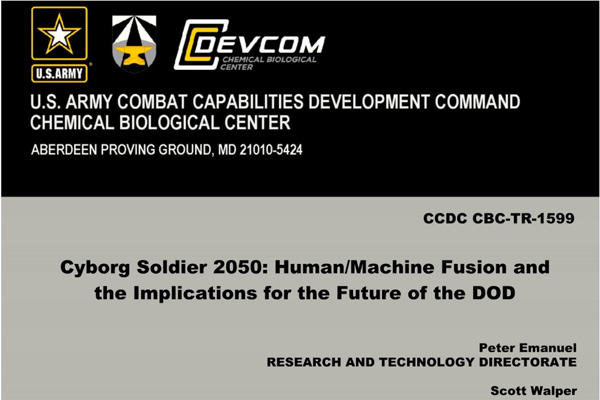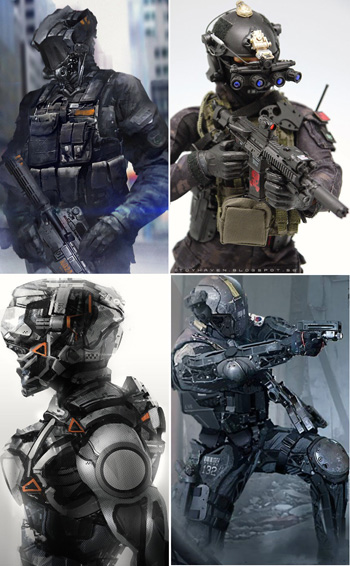Transhumanism & Artificial Intelligence
 |
 |
 |
 |
 |
 |
 |
Human Cyborgs are Just the Beginning - II
Cyborg Soldier 2050: Human/Machine Fusion
In the last article I looked at the military’s office for cyborgs and its commitment to "human augmentation."
Here let me continue, going on to the Big Kahuna, the report that begins to lay out the true intent of the military in all of this.
This large, year-long assessment – commissioned by the Office of the Under Secretary of Defense for Research and Engineering and conducted by the DoD Biotechnologies for Health and Human Performance Council – was published at the end of 2019. It is entitled:

Cyborg Soldier 2050: Human/Machine Fusion &
the Implications for the Future of the DoD
Subject terms: "Cyborg” and “Human/Machine Enhancement"
The abstract of that assessment reads:
Abstract: The Office of the Under Secretary of Defense for Research and Engineering (Alexandria, VA) established the DOD Biotechnologies for Health and Human Performance Council (BHPC) study group to continually assess research and development in biotechnology.
The BHPC group assesses scientific advances for improved health and performance with potential military application; identifies corresponding risks and opportunities and ethical, legal, and social implications; and provides senior leadership with recommendations for mitigating adversarial threats and maximizing opportunities for future U.S. forces. At the direction of the BHPC Executive Committee, the BHPC study group conducted a year-long assessment entitled “Cyborg Soldier 2050: Human/Machine Fusion and the Impact for the Future of the DOD”.
The primary objective of this effort was to forecast and evaluate the military implications of machines that are physically integrated with the human body to augment and enhance human performance over the next 30 years. This report summarizes this assessment and findings; identifies four potential military-use cases for new technologies in this area; and assesses their impact upon the DOD organizational structure, warfighter doctrine and tactics, and interoperability with U.S. allies and civil society.
This analysis was made public when published, but the COVID crisis soon overwhelmed us all and it quickly faded from public memory.
If you did not read this report back in the beginning of 2020 or if you have forgotten about it, below is the executive summary of this 50-page report (or click here to read the whole report):
Executive summary
A DoD Biotechnologies for Health and Human Performance Council (BHPC; Alexandria, VA) study group surveyed a wide range of current and emerging technologies relevant to assisting and augmenting human performance in many domains. The team used this information to develop a series of vignettes as case studies for discussion and analysis including feasibility; military application; and ethical, legal, and social implication (ELSI) considerations. Ultimately, the team selected four vignettes as being technically feasible by 2050 or earlier. The following vignettes are relevant to military needs and offer capabilities beyond current military systems:
These interactions would allow warfighters direct communication with unmanned and autonomous systems, as well as with other humans, to optimize command and control systems and operations. The potential for direct data exchange between human neural networks and microelectronic systems could revolutionize tactical warfighter communications, speed the transfer of knowledge throughout the chain of command, and ultimately dispel the “fog” of war. Direct neural enhancement of the human brain through neuro-silica interfaces could improve target acquisition and engagement and accelerate defensive and offensive systems.
 Although the control of military hardware, enhanced situational awareness, and faster data assimilation afforded by direct neural control would fundamentally alter the battlefield by the year 2050, the other three cyborg technologies are also likely to be adopted in some form by warfighters and civil society. The BHPC study group predicted that human/machine enhancement technologies will become widely available before the year 2050 and will steadily mature, largely driven by civilian demand and a robust bio-economy that is at its earliest stages of development in today’s global market.
Although the control of military hardware, enhanced situational awareness, and faster data assimilation afforded by direct neural control would fundamentally alter the battlefield by the year 2050, the other three cyborg technologies are also likely to be adopted in some form by warfighters and civil society. The BHPC study group predicted that human/machine enhancement technologies will become widely available before the year 2050 and will steadily mature, largely driven by civilian demand and a robust bio-economy that is at its earliest stages of development in today’s global market.
The global healthcare market will fuel human/machine enhancement technologies primarily to augment the loss of functionality from injury or disease, and defense applications will likely not drive the market in its later stages. The BHPC study group anticipated that the gradual introduction of beneficial restorative cyborg technologies will, to an extent, acclimatize the population to their use.
The BHPC study group projected that introduction of augmented human beings into the general population, DOD active duty personnel, and near-peer competitors will accelerate in the years following 2050 and will lead to imbalances, inequalities, and inequities in established legal, security, and ethical frameworks.
Each of these technologies will afford some level of performance improvement to end users, which will widen the performance gap between enhanced and unenhanced individuals and teams. The BHPC study group analyzed case studies and posed a series of questions to drive its assessment of the impact to DOD programs, policies, and operations. The following are the resulting recommendations (not listed in order of priority):(RM - I have only posted the top summaries for these recommendations, please go to the report for more detail). "
A quick glance at the Biological Technology Office and DARPA reveals that programatic goals of building cyborg capabilities are being conducted at an astounding rate.
The webpage search engine allows a search of the non-classified programs already being developed. So, one can go to this site and envision many, if not most of these technologies listed as being used for warfare. The military is developing human augmentation for military uses, not civilian. This is important to keep in mind.
This article was published on
Who Is Robert Malone on September 14, 2022
Given its extension TIA divided it in parts & is posting it as a series.
Continued

This large, year-long assessment – commissioned by the Office of the Under Secretary of Defense for Research and Engineering and conducted by the DoD Biotechnologies for Health and Human Performance Council – was published at the end of 2019. It is entitled:

Cyborg Soldier 2050: Human/Machine Fusion &
the Implications for the Future of the DoD
Subject terms: "Cyborg” and “Human/Machine Enhancement"
The abstract of that assessment reads:
Abstract: The Office of the Under Secretary of Defense for Research and Engineering (Alexandria, VA) established the DOD Biotechnologies for Health and Human Performance Council (BHPC) study group to continually assess research and development in biotechnology.
The BHPC group assesses scientific advances for improved health and performance with potential military application; identifies corresponding risks and opportunities and ethical, legal, and social implications; and provides senior leadership with recommendations for mitigating adversarial threats and maximizing opportunities for future U.S. forces. At the direction of the BHPC Executive Committee, the BHPC study group conducted a year-long assessment entitled “Cyborg Soldier 2050: Human/Machine Fusion and the Impact for the Future of the DOD”.
The primary objective of this effort was to forecast and evaluate the military implications of machines that are physically integrated with the human body to augment and enhance human performance over the next 30 years. This report summarizes this assessment and findings; identifies four potential military-use cases for new technologies in this area; and assesses their impact upon the DOD organizational structure, warfighter doctrine and tactics, and interoperability with U.S. allies and civil society.
This analysis was made public when published, but the COVID crisis soon overwhelmed us all and it quickly faded from public memory.
If you did not read this report back in the beginning of 2020 or if you have forgotten about it, below is the executive summary of this 50-page report (or click here to read the whole report):
Executive summary
A DoD Biotechnologies for Health and Human Performance Council (BHPC; Alexandria, VA) study group surveyed a wide range of current and emerging technologies relevant to assisting and augmenting human performance in many domains. The team used this information to develop a series of vignettes as case studies for discussion and analysis including feasibility; military application; and ethical, legal, and social implication (ELSI) considerations. Ultimately, the team selected four vignettes as being technically feasible by 2050 or earlier. The following vignettes are relevant to military needs and offer capabilities beyond current military systems:
- ocular enhancements to imaging, sight, and situational awareness;
- restoration and programmed muscular control through an optogenetic bodysuit;
- sensor web;
- auditory enhancement for communication and protection; and
- direct neural enhancement of the human brain for two-way data transfer.
These interactions would allow warfighters direct communication with unmanned and autonomous systems, as well as with other humans, to optimize command and control systems and operations. The potential for direct data exchange between human neural networks and microelectronic systems could revolutionize tactical warfighter communications, speed the transfer of knowledge throughout the chain of command, and ultimately dispel the “fog” of war. Direct neural enhancement of the human brain through neuro-silica interfaces could improve target acquisition and engagement and accelerate defensive and offensive systems.

Between reality & fiction: models for the cyborg soldier of the future
The global healthcare market will fuel human/machine enhancement technologies primarily to augment the loss of functionality from injury or disease, and defense applications will likely not drive the market in its later stages. The BHPC study group anticipated that the gradual introduction of beneficial restorative cyborg technologies will, to an extent, acclimatize the population to their use.
The BHPC study group projected that introduction of augmented human beings into the general population, DOD active duty personnel, and near-peer competitors will accelerate in the years following 2050 and will lead to imbalances, inequalities, and inequities in established legal, security, and ethical frameworks.
Each of these technologies will afford some level of performance improvement to end users, which will widen the performance gap between enhanced and unenhanced individuals and teams. The BHPC study group analyzed case studies and posed a series of questions to drive its assessment of the impact to DOD programs, policies, and operations. The following are the resulting recommendations (not listed in order of priority):(RM - I have only posted the top summaries for these recommendations, please go to the report for more detail). "
- DOD personnel must conduct global assessments of societal awareness and perceptions of human/machine enhancement technologies.
- U.S. leadership should use existing and newly developed forums (e.g., NATO) to discuss impacts to interoperability with allied partners as we approach the year 2050. This will help develop policies and practices that will maximize interoperability of forces.
- DOD should invest in the development of dynamic legal, security, and ethical frameworks under its control that anticipate emerging technologies.
- Efforts should be undertaken to reverse negative cultural narratives of enhancement technologies.
- DOD personnel should conduct tabletop wargames and targeted threat assessments to determine the doctrine and tactics of allied and adversarial forces.
- The U.S. Government should support efforts to establish a whole-of-nation approach to human/machine enhancement technologies versus a whole-of-government approach.
- The DOD should support foundational research to validate human/machine fusion technologies before fielding them and to track the long-term safety and impact on individuals and groups.
A quick glance at the Biological Technology Office and DARPA reveals that programatic goals of building cyborg capabilities are being conducted at an astounding rate.
The webpage search engine allows a search of the non-classified programs already being developed. So, one can go to this site and envision many, if not most of these technologies listed as being used for warfare. The military is developing human augmentation for military uses, not civilian. This is important to keep in mind.
Who Is Robert Malone on September 14, 2022
Given its extension TIA divided it in parts & is posting it as a series.
Continued

Posted September 28, 2022
______________________
______________________
 Volume I |
 Volume II |
 Volume III |
 Volume IV |
 Volume V |
 Volume VI |
 Volume VII |
 Volume VIII |
 Volume IX |
 Volume X |
 Volume XI |
 Special Edition |


